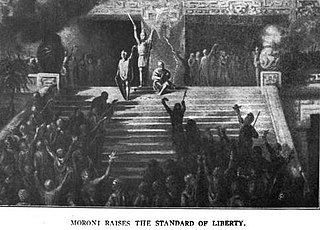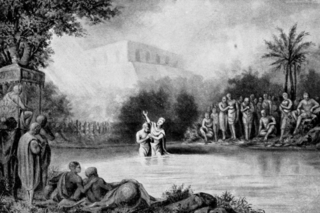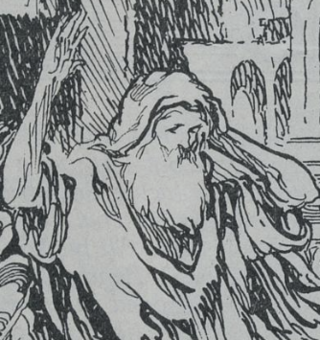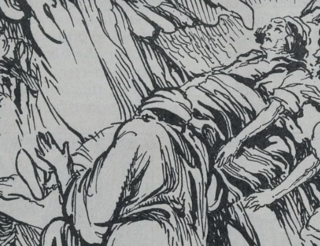
The Book of Alma: The Son of Alma, usually referred to as the Book of Alma, is one of the books that make up the Book of Mormon. The title refers to Alma the Younger, a prophet and "chief judge" of the Nephites. Alma is the longest book in the Book of Mormon and consists of sixty-three chapters, taking up almost a third of the volume.
The Book of Mosiah is one of the books which make up the Book of Mormon. The title refers to Mosiah II, a king of the Nephites at Zarahemla. The book covers the time period between ca 130 BC and 91 BC, except for when the book has a flashback into the Record of Zeniff, which starts at ca 200 BC, according to footnotes. Aside from stating that it was abridged by Mormon, the text says nothing about its authorship. Mosiah is twenty-nine chapters long.
The Book of Omni is one of the books that make up the Book of Mormon, a text that the Latter Day Saint movement regards as scripture. The book is written as the combined composition of several authors, the first of whom, Omni, provides the name of the book. According to the narrative, the book covers more than two centuries of Nephite history within one chapter of text. It refers to wars between the Nephites and Lamanites, the reign of Kings Mosiah and Benjamin, and their participation in the wars and journeys through the wilderness.

In the Book of Mormon, the Nephites are one of four groups said to have settled in the ancient Americas. The term is used throughout the Book of Mormon to describe the religious, political, and cultural traditions of the group of settlers.

The Lamanites are one of the four peoples described as having settled in the ancient Americas in the Book of Mormon, a sacred text of the Latter Day Saint movement. The Lamanites also play a role in the prophecies and revelations of the Doctrine and Covenants, another sacred text in the Latter Day Saint movement.

The Book of Mormon mentions three men named Helaman. The first was the son of King Benjamin, king of the united Nephite-Zarahemla kingdom who lived in the 2nd century BC. Besides his genealogy, information about the first Helaman is limited. His brother, Mosiah, became heir to the throne.

Zarahemla is a land in the Book of Mormon that for much of the narrative functions as the capital of the Nephites, their political and religious center. Zarahemla has been the namesake of multiple communities in the United States, has been alluded to in literature that references Mormonism, and has been portrayed in artwork depicting Book of Mormon content.

Alma is a Nephite prophet in the Book of Mormon. Initially a priest who serves in the court of King Noah, when a prophet named Abinadi preaches to the court Alma concurs with Abinadi and affirms that what the prophet said is true. For this, Noah banishes Alma and tries to have him killed. After leaving the court, Alma goes on to found a church among Noah's subjects. He eventually leads these churchgoers out from Noah's lands, through a sojourn under Lamanite rule, and to the land of Zarahemla, where their ancestors had come from a few generations earlier, where Alma becomes high priest of the Nephites' church.

In the Book of Mormon, King Benjamin, son of the first King Mosiah, is the second Nephite king to rule over Zarahemla. He is considered a king and a prophet and acts as both a spiritual and governmental leader. He is most associated with a speech to the people which begins in the second chapter of the Book of Mosiah and idealizes the life of a yeoman farmer.

King Noah is a Nephite king in the Book of Mormon who appears in the Book of Mosiah. Noah rules over a Nephite colony who came from Zarahemla and settled in the land of Lehi-Nephi, succeeding his father, Zeniff. In the Book of Mosiah, King Noah breaks away from his father's righteous teachings, committing "all manner of wickedness." Noah and his priests sentence the prophet Abinadi, who prophesied of his kingdom's downfall if they did not repent, to death by fire. During a Lamanite invasion, Noah and some of his people flee the land, and those who remain are subjected to Lamanite control. Noah attempts to forbid his men from returning to their families, and they burn him at the stake. Noah is succeeded by his son, Limhi.

In the Book of Mormon, Alma, the son of Alma is a Nephite prophet often referred to as Alma the Younger to distinguish him from his father, who is often referred to as Alma the Elder. These appellations, "the Younger" and "the Elder," are not used in the Book of Mormon; they are distinctions made by scholars, useful because both individuals were prominent during the same time period in the Book of Mormon's story and filled a similar cultural and religious role. Alma is the namesake of the Book of Alma.

In the Book of Mormon, Limhi is the third and final king of the second Nephite habitation of the land of Lehi-Nephi. He succeeds his father, Noah. Led by Ammon, Limhi and his people escape from the Lamanites with his people to the land of Zarahemla.

The two thousand stripling warriors, also known as The Army of Helaman, are an army of young men in the Book of Mormon, first mentioned in the Book of Alma. They are portrayed as extremely valiant and loyal warriors; in the text, all are wounded in battle and yet survive.

Ammonihah is a city mentioned in the Book of Mormon described as governed by lawyers and judges. When the Book of Mormon prophet Alma visits Ammonihah as part of a preaching tour, the city becomes the setting of "one of the most disturbing episodes" of the text in which Ammonihah's governing elite imprison him, exile any men converted by his preaching, and kill women and children associated with his mission by fire.

In the Book of Mormon, Zeezrom is a Nephite lawyer who, through deceit and money, seeks to gain power among the Nephites through his vocation. Alma the Younger and his missionary companion Amulek teach Zeezrom in Ammonihah. At first he resists, but is ultimately converted to the Nephite religion.

According to the Book of Mormon, Zenos was an old world prophet whose pre-Christian era writings were recorded upon the plates of brass. Zenos is quoted or paraphrased a number of times by writers in the Book of Mormon, including Nephi, Jacob, Alma, son of Alma, Nephi, son of Helaman, Samuel the Lamanite, and Mormon.
In the Book of Mormon, Zenock is a prophet who predates the events of the book's main plot and whose prophecies and statements are recorded upon brass plates possessed by the Nephites. Nephite prophets quote or paraphrase Zenock several times in the course of the narrative.

Abish is a figure in the Book of Mormon who plays a pivotal role in a missionary narrative. She is one of only three named women unique to the Book of Mormon.

The Book of Mormon monetary system is part of the setting of the Book of Mormon. It is the system of economic exchange used by the narrative's Nephites. Mormon, the internal narrator of the Book of Mormon, first introduces the system in the internal book of Alma. When Nephite missionaries Alma and Amulek preach in Ammonihah, the lawyer Zeezrom attempts to bribe Amulek, wanting him to deny the existence of God. Zeezrom offers Amulek six onties, worth about 42 days' of wages for a judge in Ammonihah. Uninfluenced, Amulek rejects the money. Setting forth the system as a background for this account, Mormon, the narrator, outlines the value relationship between precious metals and grains. This is an example of one of the many anachronisms in the Book of Mormon since there is no evidence for this sort of system in the Pre-Columbian era Americas.

Morianton's maidservant is an unnamed woman mentioned in the Book of Mormon, a religious text of the Latter Day Saint Movement. In the Book of Mormon narrative, Morianton is a Nephite insurrectionist. After he cruelly beats his maidservant, she escapes his camp and discloses Morianton's plans to Nephite military leader Captain Moroni. The maidservant's information becomes vital to Moroni's military success against Morianton. A commentary called her becoming a spy as a domestic violence survivor "one of the bravest actions in all of the Book of Mormon".











